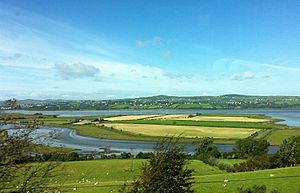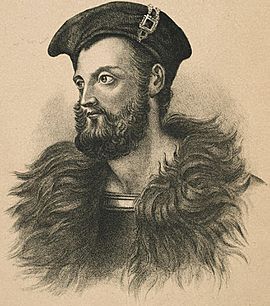Battle of Scarrifholis facts for kids
Quick facts for kids Battle of Scarrifholis |
|||||||
|---|---|---|---|---|---|---|---|
| Part of the Cromwellian Conquest of Ireland | |||||||
 River Swilly, at Letterkenny; |
|||||||
|
|||||||
| Belligerents | |||||||
| Commanders and leaders | |||||||
| Heber MacMahon Richard O'Farrell |
Charles Coote Roger Fenwick † |
||||||
| Strength | |||||||
| 3,000 infantry, 400 cavalry | 1,600 infantry, 1,200 cavalry | ||||||
| Casualties and losses | |||||||
| Between 2,000 – 3,000 killed, wounded or captured | c. 100 killed or wounded | ||||||
The Battle of Scarrifholis was a big fight that happened on June 21, 1650. It took place near Letterkenny in County Donegal, Ireland. This battle was part of the Cromwellian conquest of Ireland, when England was trying to take control of Ireland.
In this battle, an English army won. This army was loyal to the Commonwealth of England, which was the government of England at the time. Their leader was Charles Coote. They fought against the Catholic Ulster Army, led by Heber MacMahon, who was a Catholic Bishop.
Even though Coote's army was smaller, his soldiers were very experienced. Many were from the New Model Army, a strong English army. They also had many more cavalry (soldiers on horseback). After about an hour of fighting, the Ulster army broke apart and ran away. They lost most of their soldiers, leaders, weapons, and supplies. This victory helped the Commonwealth take control of northern Ireland. It also helped them complete their conquest of Ireland.
Contents
Why the Battle Happened
The Battle of Scarrifholis was part of a bigger conflict called the Irish Confederate Wars. These wars started with the Irish Rebellion of 1641. At first, the wars were between the mostly Catholic group called the Confederation and a mostly Protestant army. Both groups said they were loyal to King Charles I.
In Ulster, a region in Ireland, there was a three-sided war. This involved:
- Royalists: People loyal to King Charles I.
- Gaelic Catholics: Led by Eoghan Ó Néill.
- Presbyterian Militia: Known as the Laggan Army, supported by Scottish Covenanters.
Truce and New Alliances
In 1643, a truce was made between the King's army and the Confederation. This allowed the King's troops to go fight in England. Some Irish Protestants didn't like this truce. They switched sides and joined the English Parliamentarians. Sir Charles Coote became a Parliamentarian leader.
After King Charles I was executed in 1649, the Confederation joined forces with the Royalists. The Laggan Army and Scottish troops in Ulster also joined them.
Splits and Divisions
There were different reasons for these alliances. The Scottish Covenanters saw Cromwell and the new English government as dangerous. They also believed that kings were chosen by God, so killing a king was wrong. Because of this, they supported King Charles I's son, Charles II of England.
However, the Catholic Confederation was also divided. Some Catholic landowners wanted to keep things as they were in 1641. Others, like Ó Néill, had lost their lands in the Plantation of Ulster (when English and Scottish settlers were given land in Ireland). Ó Néill made a truce with Coote and refused to join the alliance. This meant the alliance lost a very strong fighting force in the north.
Cromwell's Arrival
In August 1649, Cromwell and his army landed in Dublin. They took control of many towns like Drogheda and Wexford. Colonel Robert Venables was sent north to take control of Ulster. Many garrisons (military forts) surrendered easily. By the end of September, Venables had taken Dundalk, Carlingford, Newry, and Belfast.
When Coote captured Coleraine, he killed many of the Scottish soldiers there.
New Leadership for Ulster Army
In November 1649, Ó Néill died. In December, Coote defeated a combined Royalist and Covenanter force. This left the Catholic Ulster army as the only group still fighting the Commonwealth in the north.
In March 1650, Heber MacMahon, the Catholic Bishop of Clogher, was chosen to lead the Ulster army. MacMahon was an important figure, but he had no military experience. He also didn't agree with the alliance with the Royalists. His election was a compromise between supporters of Ó Néill's son and his cousin, Felim Ó Néill.
The Campaign
By May 20, MacMahon and his second-in-command, Richard O'Farrell, had gathered an army near Loughgall. They had 5,000 foot soldiers and 1,000 cavalry. However, they didn't have enough weapons or cannons. Ormond promised to send supplies from Connacht.
The Irish army marched north. Their plan was to separate Coote's troops at Derry from Venables' troops at Carrickfergus. To do this, MacMahon set up forts from Ballycastle southwards. He planned to cross the River Foyle near Lifford and stay in touch with Ormond through Ballyshannon.
At this time, Coote only had 1,400 men and seemed weak. The Irish crossed the river on June 2. They fought off an attack by the Commonwealth cavalry and took Lifford. They stayed there for two weeks, while Coote pulled back to Derry.
However, the supplies Ormond promised never arrived. This left MacMahon's army short of food. On June 18, Coote got 1,000 more foot soldiers from Belfast. MacMahon had also sent men to guard the new forts. This meant his army was now around 4,000 foot soldiers and 400 cavalry.
MacMahon then moved his army to Doonglebe/Tullygay Hill. This hill overlooked a strong defensive spot called Scariffhollis. It was about 2 miles west of Letterkenny on the River Swilly. When one of his regiments left to recapture Doe Castle, the two armies became roughly equal in size.
However, Coote's soldiers were well-trained veterans. He also had three times more cavalry. When Coote arrived at Scariffhollis on June 21, MacMahon's officers told him not to fight. They thought Coote would soon have to retreat because of a lack of supplies. This would allow the Irish to leave safely.
The Battle Begins
For reasons still discussed today, MacMahon did not listen to his officers. On the morning of June 21, 1650, he ordered his troops down from the hill to fight. Coote later said that the ground was still "excessive bad" (very difficult). But it allowed him to use his cavalry. The first fighting was between the foot soldiers.
The Irish army formed a large, dense group. They had 200-300 musketeers (soldiers with muskets) in front. This might have been because they didn't have much ammunition. The battle started when Colonel Fenwick led 150 men against the Irish advance guard. They exchanged fire, and Fenwick was badly wounded. The fight then became hand-to-hand.
As Coote sent in more soldiers, the Irish musketeers fell back. They joined their main force, which now had no room to move. The English soldiers fired many shots at close range. After an hour of fierce fighting, the Irish ran out of ammunition. At this point, the Parliamentarian cavalry charged their side. The Irish army became disorganized, broke apart, and ran away.
In most battles, soldiers suffer the most casualties when they flee. This was made worse because the Irish had few cavalry and the war was very brutal. Most of the Irish foot soldiers died on the battlefield or while being chased. This included Henry Ó Néill and many officers. Some were killed even after they surrendered. It is estimated that 2,000 to 3,000 Irish soldiers were killed, wounded, or captured. Coote's army lost about 100 killed or wounded.
What Happened Next
MacMahon escaped with 200 horsemen, but he was captured a week later and executed. Phelim Ó Néill and O'Farrell made it to Charlemont. Coote's army surrounded Charlemont, and it surrendered on August 14.
With this, most of the fighting in the north ended, except for a few small forts. Limerick was captured in October 1651, and the war ended when Galway surrendered to Coote in May 1652.
Images for kids
-
River Swilly, at Letterkenny;




